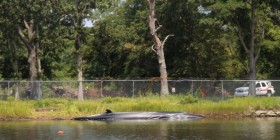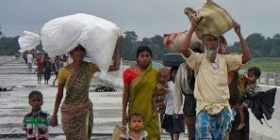At least 300 migrants are feared to have drowned after attempting to cross the Mediterranean Sea from North Africa this week in rough seas, the UN says.
UNHCR Europe director Vincent Cochetel said the incident was a “tragedy on an enormous scale”.
Nine survivors brought to the island of Lampedusa by the Italian coast guard are believed to be from West Africa.
Initial reports on Monday suggested that at least 29 migrants had died after their dinghy overturned.
The UNHCR said that dinghy was one of four that left Libya at the weekend.
Those rescued on Wednesday morning had spent days drifting without food or water in two of the other dinghies – with each said to be carrying more than 100 people.
The survivors said the fourth dinghy disappeared at sea.
Carlotta Sami, a spokeswoman for the UNHCR, said the victims had been “swallowed up by the waves,” with the youngest a child of 12.
‘Too little too late’
“This is a tragedy on an enormous scale and a stark reminder that more lives could be lost if those seeking safety are left at the mercy of the sea,” Mr Cochetel said in a statement.
The UN said the latest incident should be a message to the European Union that the current search and rescue operation in the Mediterranean was inadequate.
“Europe cannot afford to do too little too late,” Mr Cochetel added.
In November, Italy ended an operation known as Mare Nostrum, which was launched in October 2013 in response to a tragedy off Lampedusa in which 366 people died.
The year-long operation was aimed at rescuing seaborne migrants, with Italian vessels looking for ships carrying migrants that may have run into trouble off the Libyan coast.
Late last year, the UNHCR warned that Italy’s decision to end its operation in the Mediterranean would almost certainly lead to more deaths.
But other European countries, including the UK, said a rescue service for migrants could encourage them and so the operation was scaled down.
The EU now runs a border control operation, called Triton, which only operates close to Europe’s coast and with fewer ships.
Analysis: Matthew Price, BBC News, Italy
There is no way of knowing for sure whether these men, women, and children would have been saved if the former Italian search-and-rescue operation known as Mare Nostrum was still running.
But having spent a week on board an Italian navy frigate, I can be sure they would have done their utmost to save as many lives as possible.
The EU’s Triton border patrol is not designed to do that. It cannot pre-empt trouble in international waters – it can only act when lives are immediately at risk.
The Italian operation was set up differently. The naval crews knew they had one single purpose – to prevent death.
The UNHCR says almost 3,500 people died attempting to cross the Mediterranean Sea to reach Europe in 2014, making it the world’s most dangerous sea crossing for migrants.
More than 200,000 people were rescued in the Mediterranean during the same period, many under the Mare Nostrum mission prior to its abolition, and the UNHCR expects the figure to remain high in 2015.
At least a quarter of those attempting the crossing are thought to be refugees from Syria, rather than economic migrants.
In a speech to the European Parliament last year, Pope Francis called for a “united response” to the issue, warning that the Mediterranean could not be allowed to become a “vast cemetery”.






Leave a reply